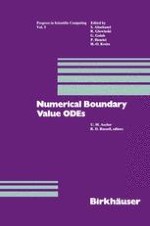In the past few years, knowledge about methods for the numerical solution of two-point boundary value problems has increased significantly. Important theoretical and practical advances have been made in a number or fronts, although they are not adequately described in any tt'xt currently available. With this in mind, we organized an international workshop, devoted solely to this topic. Tht' workshop took place in Vancouver, B.C., Canada, in July 1()"13, 1984. This volume contains the refereed proceedings of the workshop. Contributions to the workshop were in two formats. There were a small number of invited talks (ten of which are presented in this proceedings); the other contributions were in the rorm or poster sessions, for which there was no parallel activity in the workshop. We had attemptt'd to cover a number of topics and objectives in the talks. As a result, the general review papt'rs of O'Malley and Russell are intended to take a broader perspective, while the other papers are more specific. The contributions in this volume are divided (somewhat arbitrarily) into five groups. The first group concerns fundamental issues like conditioning and decoupling, which have only rect'ntly gained a proper appreciation of their centrality. Understanding of certain aspects or shooting methods ties in with these fundamental concepts. The papers of Russell, dt' Hoog and Mattheij all deal with these issues.
